
 We've had several request from our visitors to explain the difference between different basic joints: Finger Joint, Dovetail, Mitered, Rabbet Butt. This page is dedicated to that knowledge as well as tools used to create these joints. We've had several request from our visitors to explain the difference between different basic joints: Finger Joint, Dovetail, Mitered, Rabbet Butt. This page is dedicated to that knowledge as well as tools used to create these joints.← This is the ultimate workshop reference ... Giving woodworkers all the knowledge they need to choose the right joint for the job. It also features step-by-step, illustrated instructions for making over 70 joints, including mortise and tenon joints, dovetails, miters and more. |
☑ THE BUTT JOINT The butt joint is the simplest and least expensive of all joints. It is considered a rather weak joint, however, they can be strengthen using TiteBond® II Glue and perhaps brads. Corner blocks can be added for some projects. A slide-lid box works well with this joint style for function and fitting. The butt joint is the simplest and least expensive of all joints. It is considered a rather weak joint, however, they can be strengthen using TiteBond® II Glue and perhaps brads. Corner blocks can be added for some projects. A slide-lid box works well with this joint style for function and fitting. |
☑ THE MITERED JOINT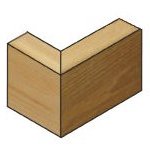 Made by mitering each corner at a 45° angle. It hides the end grain and provides a larger gluing area and can be held together with nails or screws. We recommend this joint for boxes made out of woodgrain veneer. Corners can be strengthened by adding corner splines. Plywood edges can be covered with edge banding. Made by mitering each corner at a 45° angle. It hides the end grain and provides a larger gluing area and can be held together with nails or screws. We recommend this joint for boxes made out of woodgrain veneer. Corners can be strengthened by adding corner splines. Plywood edges can be covered with edge banding. |
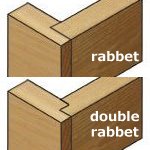 ☑ RABBET / DOUBLE RABBET BUTT JOINTThe rabbet-butt joint is stronger and more rigid than a butt joint, and is one of our most requested corner styles for crafters who plan to paint the outside of their boxes.Some of the end grain will show which can add a decorative touch. This joint is not recommended for woodgrain veneers. | |
☑ THE FINGER JOINT The finger joint is a strong, interlocking corner joint that adds a decorative touch to our custom boxes. For boxes 5" or less in height, we recommend this joint. It is a little more difficult to make, so we used a tool called The Woodrat. Perfect joints!
The finger joint is a strong, interlocking corner joint that adds a decorative touch to our custom boxes. For boxes 5" or less in height, we recommend this joint. It is a little more difficult to make, so we used a tool called The Woodrat. Perfect joints! |
☑ THE DOVETAIL JOINT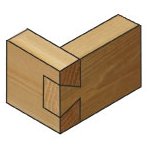 Here is a strong joint that adds a decorative touch to a custom box. These are little more labor intensive. We use our Leigh Dovetail Jig, for beautiful joints everytime. These joints have very good mechanical strength held together with water-resistant glue. Here is a strong joint that adds a decorative touch to a custom box. These are little more labor intensive. We use our Leigh Dovetail Jig, for beautiful joints everytime. These joints have very good mechanical strength held together with water-resistant glue. |
☑ Tutorial: Build a Box Joint Jig   | |
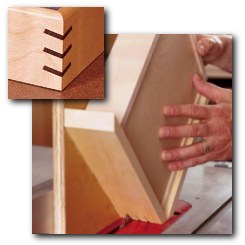 Featured Article: Featured Article:☑ Creating Splined-Miter JointsCreate a new spin on traditional splined miter joints. Just install the splines at an angle, as shown with this Maple & Walnut letter tray. The results are eye-catching! By varying the number and placement of the splines, you can come up with other designs.First, make a simple spline-cutting jig for your tablesaw. Then, mark three evenly spaced spline locations on a piece of scrap the same width as the tray side ... ▸ more info |
☑ Leigh® Super Dovetail Jigs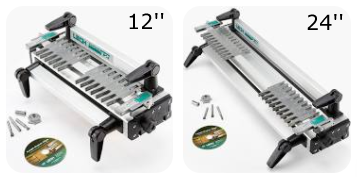 ▸ Leigh® 12" Dovetail Jig
▸ Leigh® 12" Dovetail Jig▸ Leigh® D4R Pro 24" Dovetail Jig Leigh Super Jigs offer extraordinary joint making capability at exceptional price points. Super Jigs are available in sizes to satisfy the needs of every woodworker and every budget. |
|
With the Super Jigs you're not limited to one bit and one depth of cut. Just select any of the five half-blind bits available and rout half-blind joints in the depth that best suits your project. The finger assembly can also produce two sizes of box joints, 5/16" and 5/8".
The amazing joint making capability of Super Jigs is due in part to the revolutionary new LEIGH E-Bush. Very precise adjustments for fit are made easily with the E-Bush. Settings are changed using the included pin wrench and the uniquely shaped locking nut makes tightening the E-Bush a snap.
|
| Includes: ½"-8° dovetail bit, ½"-14° dovetail bit, 5/16" straight bit, ½" to 8mm collet reducer, sliding dovetail fence, Half-blind bridge piece material, E-Bush, fully illustrated User Guide and Instructional DVD. |